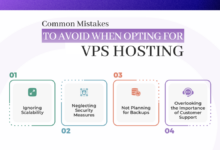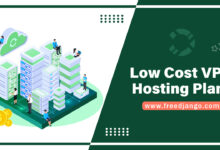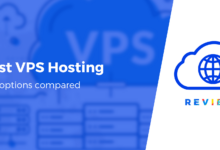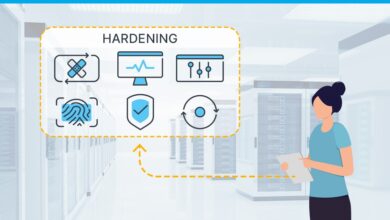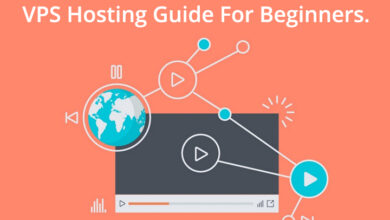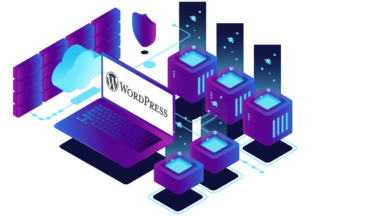VPS Hosting for E-commerce: Faster, Secure Stores
VPS Hosting for E-commerce: The Key to Faster and Secure Stores. In today’s competitive online marketplace, a robust and reliable web hosting solution is paramount for e-commerce success. This comprehensive guide explores the advantages of Virtual Private Server (VPS) hosting for online businesses, detailing how it delivers superior speed, enhanced security, and unparalleled scalability compared to shared hosting options. We’ll delve into the technical aspects, security best practices, cost considerations, and strategies for optimizing your e-commerce store’s performance on a VPS.
From understanding the fundamental architecture of a VPS to selecting the right provider and implementing effective security measures, we’ll equip you with the knowledge to make informed decisions and propel your online store to new heights. We’ll cover essential topics like performance optimization, data backup, disaster recovery, and seamless integration with popular e-commerce platforms, ensuring your online business thrives in the digital landscape.
Understanding VPS Hosting Fundamentals
VPS hosting, or Virtual Private Server hosting, offers a compelling middle ground between shared hosting and dedicated servers for e-commerce businesses. It provides the scalability and control often needed for growing online stores without the significant upfront investment of a dedicated server. Understanding the architecture and capabilities of VPS hosting is crucial for selecting the right solution.
VPS hosting leverages virtualization technology to divide a single physical server into multiple isolated virtual servers. Each virtual server, or VPS, functions as a standalone server with its own operating system, resources (CPU, RAM, storage), and administrative access. This isolation ensures that the performance of one VPS is not affected by others on the same physical server, unlike shared hosting. This architecture offers a balance of cost-effectiveness and performance, making it an attractive option for many businesses.
VPS Server Architecture and Components
A VPS server comprises several key components working together. The underlying physical hardware includes the server’s CPU, RAM, hard drives (often SSDs for improved speed), and network interfaces. On top of this hardware sits the hypervisor, a software layer that manages the virtual servers. The hypervisor allocates resources to each VPS, ensuring isolation and preventing resource contention. Each VPS then runs its own operating system (like Linux or Windows), web server software (like Apache or Nginx), database software (like MySQL or PostgreSQL), and the e-commerce platform itself (such as Magento, Shopify, or WooCommerce). This layered architecture allows for efficient resource utilization and robust security.
Comparison of Shared Hosting, Dedicated Servers, and VPS
Shared hosting, dedicated servers, and VPS hosting represent different points on a spectrum of server resource allocation and control. Shared hosting places multiple websites on a single server, sharing resources. This is cost-effective but offers limited control and scalability, making it less suitable for high-traffic e-commerce sites. Dedicated servers, on the other hand, provide a complete physical server dedicated to a single client, offering maximum control and performance but at a significantly higher cost. VPS hosting strikes a balance, offering more control and scalability than shared hosting while being significantly more affordable than a dedicated server. The isolation of resources within a VPS provides a level of performance and security closer to a dedicated server without the substantial expense.
Scalability and Flexibility of VPS Hosting
VPS hosting offers superior scalability and flexibility compared to shared hosting. As an e-commerce business grows, it can easily upgrade its VPS resources (CPU, RAM, storage, bandwidth) to accommodate increased traffic and data volume. This contrasts with shared hosting, where scaling options are limited. Dedicated servers also offer scalability, but the process of upgrading often involves more significant downtime and administrative overhead. The flexibility of VPS hosting extends to software customization as well. Administrators have greater control over the server’s operating system and software configurations, allowing for optimized performance and security tailored to the specific needs of the e-commerce platform.
Comparison of Key Features of Different VPS Hosting Providers
Choosing the right VPS provider depends on various factors, including price, performance, features, and support. The following table compares some key features of different VPS hosting providers (Note: Specific pricing and features are subject to change and should be verified directly with the provider).
| Provider | Starting Price (USD/month) | CPU Cores | RAM (GB) | Storage (GB) |
|---|---|---|---|---|
| Provider A | 10 | 1 | 2 | 50 |
| Provider B | 15 | 2 | 4 | 100 |
| Provider C | 20 | 4 | 8 | 200 |
| Provider D | 25 | 8 | 16 | 500 |
E-commerce Specific Requirements for VPS Hosting
Running a successful e-commerce website demands a robust and reliable hosting solution. While shared hosting might suffice for smaller ventures, the scalability, security, and performance benefits of a Virtual Private Server (VPS) become increasingly crucial as your online store grows. This section will delve into the specific technical requirements and considerations for choosing a VPS to power your e-commerce platform.
E-commerce websites have unique technical demands that go beyond simple website hosting. They require high availability, robust security features, and the ability to handle fluctuating traffic loads, particularly during peak shopping seasons or promotional campaigns. A poorly configured or under-resourced hosting environment can lead to slow loading times, security vulnerabilities, and ultimately, lost sales.
Server Resource Requirements for E-commerce
The performance of your e-commerce site directly correlates with the server resources allocated to it. Sufficient CPU power ensures smooth processing of transactions and quick page load times. Ample RAM allows for efficient handling of multiple simultaneous requests, preventing slowdowns or crashes during peak traffic. Finally, substantial storage space is necessary to accommodate product images, customer data, and other essential files. For instance, a rapidly growing online retailer selling high-resolution images might require significantly more storage than a smaller business with a limited product catalog. A poorly provisioned server with insufficient CPU, RAM, or storage can result in frustrated customers, abandoned shopping carts, and ultimately, lost revenue. The ideal resource allocation depends heavily on the size and anticipated growth of the e-commerce business. A small business might start with a smaller VPS configuration, scaling up as needed. Larger businesses, on the other hand, might require a more substantial initial investment in server resources.
Security Considerations for E-commerce VPS Hosting
Security is paramount for e-commerce websites. Hosting your store on a VPS provides a degree of isolation from other websites, enhancing security compared to shared hosting. However, proactive security measures are still crucial. A compromised e-commerce site can lead to significant financial losses, reputational damage, and legal liabilities. Data breaches, for example, can result in the exposure of sensitive customer information, leading to severe consequences. The unique security challenges of e-commerce include protecting sensitive customer data (payment information, addresses, etc.), preventing unauthorized access to the website’s administration panel, and safeguarding against various cyber threats, such as SQL injection attacks and DDoS attacks.
Essential Security Measures for an E-commerce VPS
Implementing robust security measures is vital for protecting your e-commerce website and customer data. This requires a multi-layered approach.
A comprehensive security strategy should include:
- Regular software updates: Keeping your operating system, web server software (e.g., Apache or Nginx), and all other software components up-to-date with the latest security patches is essential to mitigate known vulnerabilities.
- Strong passwords and two-factor authentication: Employing strong, unique passwords for all administrative accounts and enabling two-factor authentication adds an extra layer of protection against unauthorized access.
- Regular security audits and penetration testing: Periodically assessing your website’s security posture through audits and penetration testing helps identify and address potential vulnerabilities before they can be exploited.
- SSL/TLS certificates: Using an SSL/TLS certificate encrypts the communication between your website and customers’ browsers, protecting sensitive data transmitted during transactions. This is crucial for building trust and complying with industry standards like PCI DSS.
- Firewall configuration: Configuring a firewall to restrict unauthorized access to your server is a fundamental security measure. This involves carefully defining which ports are open and which are blocked.
- Regular backups: Regularly backing up your website’s data is crucial for disaster recovery. In the event of a security breach or other unforeseen event, having backups allows you to restore your website quickly and minimize downtime.
- Intrusion detection and prevention systems (IDS/IPS): Implementing an IDS/IPS helps detect and prevent malicious activity on your server. These systems monitor network traffic for suspicious patterns and can automatically block or alert you to potential threats.
Performance Optimization on a VPS for E-commerce
Optimizing your e-commerce website’s performance on a Virtual Private Server (VPS) is crucial for maximizing sales and ensuring customer satisfaction. A slow-loading website leads to high bounce rates and lost revenue. This section details strategies to enhance speed and efficiency, focusing on website loading speed, database performance, and caching mechanisms.
Website Loading Speed Optimization Strategies
Several techniques significantly improve website loading speed. These strategies focus on reducing the time it takes for all website components to load, leading to a smoother user experience.
- Optimize Images: Compress images using tools like TinyPNG or ImageOptim to reduce file sizes without significant quality loss. Using optimized image formats like WebP can further improve loading times. For example, a 2MB image compressed to 500KB will drastically reduce loading time.
- Leverage Browser Caching: Configure your web server to enable browser caching, allowing browsers to store static assets (images, CSS, JavaScript) locally, reducing server requests on subsequent visits. This is particularly beneficial for repeat customers.
- Minify CSS and JavaScript: Remove unnecessary characters (whitespace, comments) from CSS and JavaScript files to reduce their size, leading to faster downloads. Tools like UglifyJS and CSSNano automate this process.
- Use a Content Delivery Network (CDN): A CDN distributes your website’s content across multiple servers globally, reducing latency for users in different geographical locations. This is especially crucial for businesses with a global customer base. For instance, a customer in Europe would experience significantly faster loading times if the website’s content is served from a server located in Europe rather than one in the US.
- Enable HTTP/2: HTTP/2 is a newer protocol that improves website performance by enabling multiplexing (sending multiple requests simultaneously) and header compression, resulting in faster page load times.
Database Performance Improvement for E-commerce Applications
A well-optimized database is vital for the smooth functioning of an e-commerce website. Slow database queries can significantly impact website responsiveness, especially during peak traffic periods.
- Database Indexing: Properly indexing database tables speeds up data retrieval. Indexes are like a book’s index—they allow the database to quickly locate specific data without scanning the entire table. For example, indexing product names and IDs significantly speeds up product searches.
- Query Optimization: Analyze and optimize database queries to minimize execution time. Inefficient queries can consume excessive resources and lead to slowdowns. Tools like MySQL’s `EXPLAIN` command can help identify areas for improvement.
- Database Caching: Implement database caching to store frequently accessed data in memory, reducing the number of database queries. This significantly speeds up data retrieval for commonly accessed information, such as product details or customer information. Memcached and Redis are popular caching solutions.
- Database Sharding: For very large databases, consider sharding—splitting the database into smaller, more manageable parts across multiple servers. This distributes the load and improves performance. This is particularly beneficial for large e-commerce platforms with millions of products and customers.
The Role of Caching Mechanisms in Enhancing E-commerce Website Speed
Caching plays a pivotal role in speeding up e-commerce websites. By storing frequently accessed data in memory, caching reduces the load on the server and speeds up response times.
Caching mechanisms can operate at different levels: browser caching (discussed earlier), server-side caching (discussed below), and database caching (also discussed earlier). Each level contributes to overall performance improvement. For example, caching product images reduces the load on the server and the database, resulting in faster page loads.
Step-by-Step Guide on Configuring Server-Side Caching for E-commerce
Server-side caching stores frequently accessed content on the server, reducing the need to regenerate it every time a request is made. This significantly improves website speed and reduces server load.
- Choose a Caching Solution: Select a suitable caching solution like Varnish Cache, Redis, or Memcached. The choice depends on your specific needs and the technology stack used by your e-commerce platform.
- Install and Configure the Caching Solution: Follow the installation instructions for your chosen caching solution. This typically involves downloading the software, installing it on your VPS, and configuring its settings.
- Integrate with your Application: Integrate the caching solution with your e-commerce application. This involves modifying your application’s code to interact with the cache, storing and retrieving data as needed. This may involve using specific APIs or libraries provided by your caching solution.
- Configure Cache Invalidation: Implement a mechanism to invalidate cached data when it becomes outdated. This ensures that users always see the most up-to-date information. This might involve using cache tags or time-based expiration policies.
- Monitor Cache Performance: Monitor the cache’s performance to ensure it’s functioning effectively and identify any potential issues. This includes monitoring cache hit rates, cache misses, and overall server load.
Security Best Practices for E-commerce VPS
Protecting your e-commerce business from online threats is paramount. A secure VPS is the cornerstone of a successful and trustworthy online store, safeguarding sensitive customer data and maintaining operational integrity. This section outlines crucial security measures to implement on your e-commerce VPS.
SSL/TLS Certificate Implementation for Secure Transactions
Implementing an SSL/TLS certificate is fundamental for securing online transactions. This certificate encrypts the communication between the customer’s web browser and your e-commerce server, protecting sensitive data like credit card information and personal details from interception. A valid SSL/TLS certificate, indicated by a padlock icon in the browser’s address bar, builds trust with customers, encouraging them to complete purchases confidently. The process involves obtaining a certificate from a trusted Certificate Authority (CA), installing it on your server, and configuring your web server (e.g., Apache or Nginx) to use it. Failure to implement SSL/TLS leaves your customers vulnerable to man-in-the-middle attacks and data breaches, severely damaging your reputation and potentially leading to legal repercussions.
Regular Security Updates and Patching
Regularly updating your server’s operating system, applications, and plugins is crucial for mitigating known vulnerabilities. Software developers constantly release security patches to address newly discovered flaws that could be exploited by malicious actors. Neglecting updates leaves your system exposed to attacks, potentially leading to data breaches, website defacement, or even complete system compromise. A robust patching schedule, ideally automated, is essential. This includes not only the operating system but also all e-commerce platform software, plugins, themes, and any custom-developed applications. Prioritize critical security updates immediately and test any updates in a staging environment before deploying them to your live server.
Common E-commerce Security Threats and Mitigation Strategies
E-commerce websites face a range of security threats. SQL injection attacks attempt to manipulate database queries to gain unauthorized access to data. Mitigation involves using parameterized queries and input validation. Cross-site scripting (XSS) attacks inject malicious scripts into websites to steal user data or redirect users to malicious sites. Implementing robust input sanitization and output encoding can prevent XSS attacks. Denial-of-service (DoS) attacks overwhelm a server with traffic, rendering it inaccessible. Utilizing a Content Delivery Network (CDN) and implementing rate limiting can help mitigate DoS attacks. Brute-force attacks attempt to guess passwords by trying numerous combinations. Strong password policies, account lockout mechanisms, and two-factor authentication significantly reduce the risk. Malware infections can compromise your server and steal data. Regularly scanning your server for malware and using a web application firewall (WAF) are essential preventative measures.
Security Checklist for Robust E-commerce VPS Security
A comprehensive security checklist is vital for maintaining a secure e-commerce environment. This checklist should include:
- Regular OS and application updates
- Strong and unique passwords
- Two-factor authentication for all administrative accounts
- Implementation of a web application firewall (WAF)
- Regular security audits and penetration testing
- Robust backup and recovery strategy
- Use of an intrusion detection system (IDS) or intrusion prevention system (IPS)
- Monitoring server logs for suspicious activity
- SSL/TLS certificate installation and renewal
- Compliance with relevant data privacy regulations (e.g., GDPR, CCPA)
Implementing these security measures provides a multi-layered defense against common threats, significantly reducing the risk of security breaches and maintaining the trust and confidence of your customers.
Choosing the Right VPS Provider for E-commerce
Selecting the ideal VPS provider is crucial for the success of your e-commerce venture. The right provider ensures your online store enjoys optimal performance, robust security, and seamless scalability. A poorly chosen provider can lead to downtime, security breaches, and ultimately, lost revenue. This section will guide you through the process of selecting a provider that aligns with your specific e-commerce needs.
Comparing VPS Hosting Provider Features
Various VPS hosting providers offer a range of features, each catering to different needs and budgets. Key features to compare include storage capacity, bandwidth allocation, server location (for latency optimization), control panel options (cPanel, Plesk, etc.), operating system choices (Linux, Windows), and the level of technical support provided. For instance, some providers specialize in managed VPS solutions, offering proactive monitoring and maintenance, while others provide unmanaged VPS, requiring more technical expertise from the user. Consider comparing providers like AWS, Google Cloud Platform, Azure, DigitalOcean, and Vultr, each offering distinct strengths in different areas. AWS, for example, might be favored for its extensive scalability, while DigitalOcean is often praised for its simplicity and ease of use.
Key Factors in Selecting a VPS Provider for E-commerce
Several critical factors must be considered when choosing a VPS provider for your e-commerce platform. These include:
- Scalability: Your VPS should easily handle fluctuations in traffic, especially during peak seasons or promotional campaigns. Look for providers that offer easy vertical and horizontal scaling options.
- Security: Robust security measures are paramount for e-commerce. Ensure the provider offers features like firewalls, DDoS protection, and regular security updates. Consider providers with certifications like ISO 27001.
- Uptime Guarantee: A high uptime guarantee (ideally 99.9% or higher) minimizes downtime, protecting your business’s reputation and sales.
- Technical Support: Reliable and responsive technical support is vital for resolving issues promptly. Consider the availability of 24/7 support via phone, email, and live chat.
- Pricing and Contracts: Evaluate the pricing models offered (hourly, monthly, annual) and the flexibility of contract terms. Understand any hidden fees or charges.
- Location: Choose a server location that minimizes latency for your target audience. A server closer to your customers will result in faster loading times.
Negotiating Pricing and Service Level Agreements (SLAs)
Negotiating favorable pricing and SLAs is often possible, especially for long-term contracts or high-volume usage. Thoroughly research market rates before engaging in negotiations. Clearly articulate your requirements and desired features, and be prepared to compare offers from multiple providers. Don’t hesitate to ask for discounts or bundled services. For example, you might negotiate a lower price in exchange for a longer-term contract or a higher upfront payment. Ensure the SLA clearly defines uptime guarantees, response times for support requests, and procedures for resolving service disruptions.
Decision-Making Matrix for Choosing a VPS Provider
The following matrix can assist in comparing different VPS providers based on the key factors discussed above. Each provider is scored on a scale of 1 to 5, with 5 being the best.
| Provider | Scalability | Security | Uptime Guarantee | Support |
|---|---|---|---|---|
| Provider A | 4 | 5 | 4 | 3 |
| Provider B | 3 | 4 | 5 | 5 |
| Provider C | 5 | 3 | 4 | 4 |
| Provider D | 4 | 4 | 3 | 3 |
Scalability and Growth with E-commerce VPS Hosting
Choosing the right VPS hosting solution is crucial for the long-term success of any e-commerce business. Scalability, the ability to adapt to fluctuating demands and increasing business needs, is a paramount consideration. A well-chosen VPS allows your online store to grow without being constrained by limitations in resources or performance.
The ability to effortlessly scale your VPS infrastructure is essential for handling periods of high traffic and maintaining a seamless customer experience. This involves strategic planning for resource allocation, effective management of peak demand, and leveraging the inherent scalability benefits of cloud-based VPS solutions. This section will outline practical strategies and considerations for ensuring your e-commerce platform can handle growth effectively.
Strategies for Scaling a VPS to Accommodate Increasing Traffic and Sales
Successful scaling involves proactive planning and the ability to adjust resources as needed. This includes anticipating future growth and implementing strategies to ensure your VPS can handle increased traffic and sales without compromising performance. Regular monitoring of server metrics, such as CPU usage, RAM consumption, and disk I/O, provides crucial insights into resource utilization and potential bottlenecks. Based on this data, you can proactively adjust your VPS configuration to prevent performance degradation. For instance, if CPU usage consistently peaks during specific times, upgrading to a VPS with more processing power would be a prudent step. Similarly, increasing RAM allocation can address memory-related bottlenecks, while expanding storage capacity can accommodate growing product databases and media files.
Handling Peak Demand Periods Effectively
Peak demand periods, such as holiday shopping seasons or promotional campaigns, present unique challenges to e-commerce businesses. To mitigate potential performance issues during these times, implementing strategies for managing peak demand is critical. This might involve temporarily scaling up resources, such as adding more CPU cores or RAM, to handle the surge in traffic. Cloud-based VPS solutions excel in this area, offering the ability to quickly and easily provision additional resources on demand. Alternatively, employing caching mechanisms, such as content delivery networks (CDNs), can significantly reduce the load on your primary server by serving static content from geographically distributed servers. Load balancing techniques distribute incoming traffic across multiple servers, ensuring no single server becomes overloaded. Careful monitoring during these periods allows for real-time adjustments and ensures a smooth customer experience.
Benefits of Using Cloud-Based VPS Solutions for Scalability
Cloud-based VPS solutions offer significant advantages in terms of scalability compared to traditional dedicated servers. Their inherent flexibility allows for rapid scaling of resources as needed. Unlike traditional VPS, where upgrading often involves a downtime period, cloud-based solutions frequently permit on-the-fly resource adjustments without service interruptions. This agility is particularly crucial for e-commerce businesses, ensuring consistent availability and performance even during periods of rapid growth. Furthermore, cloud providers typically offer a range of pricing models, allowing businesses to pay only for the resources they consume. This pay-as-you-go approach can significantly reduce costs compared to over-provisioning resources with a traditional VPS. The ability to easily scale up or down resources based on real-time demand translates into cost-effectiveness and optimal resource utilization.
Upgrading Resources on a VPS as the E-commerce Business Grows
As your e-commerce business grows, you may need to upgrade your VPS resources to maintain optimal performance. This might involve increasing CPU cores, RAM, storage space, or bandwidth. Most VPS providers offer straightforward upgrade paths, allowing you to seamlessly transition to a more powerful configuration. Before upgrading, it is important to assess your current resource utilization and project future needs. This involves analyzing server logs, monitoring performance metrics, and forecasting traffic growth. Based on this analysis, you can choose an appropriate upgrade path that aligns with your business needs and budget. The process typically involves selecting a new VPS plan with the desired specifications and then initiating the upgrade through your hosting provider’s control panel. Minimal downtime is often involved, ensuring a smooth transition. Remember to test the upgraded VPS thoroughly after the upgrade to confirm that everything functions as expected.
Cost Considerations of VPS Hosting for E-commerce
Choosing a VPS hosting plan requires careful consideration of costs. The total expense isn’t just the monthly subscription fee; several other factors significantly influence the overall price. Understanding these components allows for informed decision-making and budget optimization.
VPS hosting costs are comprised of several elements. The base price reflects the server’s resources (CPU, RAM, storage) and location. However, additional charges can arise from bandwidth usage exceeding allocated limits, add-on features (like managed services or backups), and potential overages if your e-commerce store experiences unexpected traffic spikes.
Typical VPS Hosting Costs and Associated Expenses
The monthly cost of a VPS hosting plan varies widely based on the provider, server specifications, and location. Entry-level plans might start around $10-$20 per month, offering basic resources suitable for smaller e-commerce businesses with low traffic. Mid-range plans, ideal for growing businesses, typically cost $50-$100 per month and provide more robust resources. High-end plans for large-scale e-commerce operations can exceed $100 per month, offering significant computing power and storage capacity. Beyond the base plan, expenses can include:
* Bandwidth overages: If your website receives more traffic than your allocated bandwidth, you’ll likely incur extra charges.
* Storage overages: Similar to bandwidth, exceeding your allocated storage can lead to additional fees.
* Managed services: Some providers offer managed services, such as server management, security monitoring, and backups, for an added monthly cost.
* IP addresses: Additional IP addresses may be needed for specific functionalities and will often incur extra charges.
* SSL certificates: While often included in some plans, obtaining and renewing SSL certificates can be an additional expense.
Optimizing VPS Resource Usage to Reduce Costs
Effective resource management is crucial for minimizing VPS hosting expenses. Several strategies can significantly reduce costs:
* Right-sizing your server: Choose a VPS plan with resources that accurately match your current and projected needs. Avoid over-provisioning, as it leads to unnecessary expense.
* Monitoring resource utilization: Regularly monitor CPU usage, RAM consumption, and disk I/O to identify potential bottlenecks and optimize resource allocation. Tools like cPanel provide valuable insights into resource usage.
* Caching strategies: Implementing caching mechanisms (like Varnish or Redis) can significantly reduce server load and improve website performance, minimizing the need for expensive upgrades.
* Database optimization: Optimize your database queries and schema design to improve efficiency and reduce database server load.
* Content Delivery Network (CDN): A CDN distributes your website’s content across multiple servers globally, reducing the load on your VPS and improving website speed for users in different locations.
Long-Term Cost-Effectiveness of VPS Hosting Compared to Other Options
VPS hosting often proves more cost-effective in the long run compared to shared hosting, especially for growing e-commerce businesses. Shared hosting can become restrictive as your website traffic increases, leading to performance issues and potential downtime. While initial VPS costs may be higher than shared hosting, the increased control, scalability, and performance often outweigh the initial investment. Dedicated servers, while offering maximum control and resources, are significantly more expensive than VPS and are generally only necessary for very large e-commerce operations.
Cost Comparison of Different VPS Plans
The following table illustrates a hypothetical comparison of different VPS plans, highlighting the variations in cost and resources:
| Plan Name | Monthly Cost | CPU Cores | RAM (GB) | Storage (GB) |
|---|---|---|---|---|
| Basic | $15 | 1 | 2 | 50 |
| Standard | $50 | 2 | 8 | 200 |
| Premium | $150 | 4 | 16 | 500 |
| Enterprise | $300 | 8 | 32 | 1000 |
Data Backup and Disaster Recovery for E-commerce VPS
For e-commerce businesses, the website is the lifeblood of operations. Data loss, whether due to hardware failure, cyberattack, or human error, can lead to significant financial losses, reputational damage, and disruption of customer service. Implementing robust data backup and disaster recovery strategies is therefore crucial for ensuring business continuity and minimizing the impact of unforeseen events. This section outlines essential practices for protecting your e-commerce data and ensuring swift recovery in case of disaster.
The Importance of Regular Data Backups for E-commerce Websites
Regular data backups are paramount for e-commerce websites due to the constant flow of transactions, customer data, and product information. Losing this data can mean losing sales, customer trust, and potentially the entire business. A comprehensive backup strategy protects against various threats, including hardware malfunctions, software errors, malware infections, accidental deletions, and even natural disasters. The frequency of backups should align with the rate of data change; for high-transaction volume sites, more frequent backups (hourly or even more often) might be necessary. Failing to implement regular backups leaves your business vulnerable to significant and potentially irreparable damage.
Data Backup Strategies and Their Implementation
Several strategies exist for backing up e-commerce data, each with its own advantages and disadvantages.
One common approach is local backups, where data is copied to an internal or external hard drive connected to the VPS server. While simple to implement, this method is vulnerable to physical damage or theft affecting the backup itself. Remote backups, on the other hand, store copies of data on a separate server, often in a different geographical location. This offers enhanced protection against local disasters. Cloud-based backup services are a popular form of remote backup, offering scalability, redundancy, and automated backups. They typically utilize various strategies such as incremental backups (only saving changed data since the last backup) and differential backups (saving changes since the last full backup) to optimize storage and transfer times.
Another strategy involves employing a combination of these methods, known as a multi-tiered backup approach. This approach typically involves local backups for quick recovery of minor issues, coupled with remote backups for long-term data protection and disaster recovery. Consider using a combination of on-site, off-site, and cloud-based backups to maximize protection against various failure scenarios.
Disaster Recovery Planning and its Significance for Business Continuity
A comprehensive disaster recovery plan (DRP) outlines the steps to be taken in the event of a major disruption to the e-commerce website’s operations. This plan should detail procedures for data restoration, system recovery, and business continuity. A well-defined DRP minimizes downtime, reduces data loss, and safeguards the business’s reputation and customer relationships. Without a DRP, recovery from a significant event can be chaotic, leading to prolonged downtime and potentially irreversible damage.
Creating and Testing a Disaster Recovery Plan: A Step-by-Step Guide
Creating a robust DRP requires a structured approach.
- Risk Assessment: Identify potential threats such as hardware failure, cyberattacks, natural disasters, and human error. Assess the likelihood and potential impact of each threat.
- Data Backup Strategy: Define the backup frequency, methods (local, remote, cloud), and retention policies. Specify the types of data to be backed up (customer data, product information, transactional data, website files, etc.).
- Recovery Procedures: Detail the steps to restore data and systems from backups. This should include instructions for accessing backup locations, restoring databases, and reconfiguring the server environment.
- Communication Plan: Establish procedures for communicating with customers, employees, and stakeholders during and after a disaster. This includes informing customers about service disruptions and providing updates on recovery efforts.
- Testing and Review: Regularly test the DRP to ensure its effectiveness and identify areas for improvement. This might involve simulating a disaster scenario and restoring data and systems from backups. Regular review and updates are essential to adapt the plan to evolving business needs and emerging threats.
Managing and Monitoring an E-commerce VPS
Effective management and monitoring are crucial for ensuring the smooth operation and optimal performance of your e-commerce VPS. Proactive monitoring allows for early detection of potential problems, minimizing downtime and maximizing customer satisfaction. This section details techniques and tools to achieve this.
Server Performance and Resource Utilization Monitoring
Regular monitoring of server performance and resource utilization is essential for identifying bottlenecks and potential issues before they impact your e-commerce store. Key metrics to track include CPU usage, memory consumption, disk I/O, and network traffic. High CPU usage, for instance, could indicate a poorly optimized application or a surge in traffic. Similarly, consistently high memory consumption might necessitate upgrading your VPS resources. Low disk I/O could be indicative of a problem with storage, while unusually high network traffic might point to a security breach or a DDoS attack. Analyzing these metrics over time helps establish baselines and identify anomalies.
Utilizing Server Monitoring Tools for Proactive Issue Detection
Several tools provide comprehensive server monitoring capabilities, enabling proactive issue detection. These tools typically offer dashboards displaying real-time performance metrics, automated alerts for critical events, and historical data for trend analysis. Examples include Nagios, Zabbix, and Datadog. Nagios, for example, allows for the creation of custom monitoring checks tailored to specific applications and services. Zabbix provides a robust framework for monitoring various aspects of your infrastructure, including network devices. Datadog offers advanced features such as anomaly detection and automated remediation capabilities. The choice of tool depends on the complexity of your infrastructure and your specific monitoring needs.
Troubleshooting Common VPS Issues
Troubleshooting common VPS issues often involves a systematic approach. For instance, slow website loading speeds might be due to insufficient server resources, database performance issues, or inefficient code. Identifying the root cause requires analyzing server logs, performance metrics, and network traffic data. Tools like tcpdump can capture network traffic to identify network-related problems. Similarly, analyzing application logs can pinpoint errors in the code or configuration issues. Regular backups are crucial; if a problem arises, restoring from a recent backup can minimize downtime.
Regular Server Maintenance and its Impact on Performance
Regular server maintenance is critical for maintaining optimal performance and security. This includes tasks such as updating the operating system and software, applying security patches, and cleaning up unnecessary files. Ignoring these tasks can lead to security vulnerabilities, performance degradation, and increased risk of downtime. A scheduled maintenance plan, including automated tasks, can ensure that these crucial steps are consistently performed. For example, automated updates can be configured to install security patches overnight to minimize disruption. Regular database optimization, including indexing and query optimization, is also crucial for maintaining database performance. This ensures efficient data retrieval and reduces website loading times.
Integrating E-commerce Platforms with VPS Hosting
Successfully integrating your e-commerce platform with your VPS is crucial for a smooth, efficient, and secure online store. This process involves several steps, from initial platform selection and installation to ongoing maintenance and optimization. Understanding the nuances of this integration will ensure your online business thrives.
Installing and Configuring Popular E-commerce Platforms
The installation process varies slightly depending on the chosen platform (e.g., Magento, Shopify, WooCommerce, PrestaShop). Generally, it involves obtaining the platform software, connecting to your VPS via SSH, and following the platform’s specific installation instructions. This often includes setting up a database (like MySQL or MariaDB), configuring web server settings (like Apache or Nginx), and providing necessary credentials. For example, installing WooCommerce on a VPS with Apache and MySQL typically involves downloading the WooCommerce plugin, uploading it to your WordPress installation via FTP or the WordPress admin panel, and then activating the plugin. Similarly, installing Magento involves downloading the Magento software, extracting it to your VPS, configuring the database connection details in the installation script, and completing the installation wizard. Each platform has its own documentation to guide users through this process.
Common Integration Challenges and Solutions
Several challenges can arise during platform integration. Database connection errors are common, often stemming from incorrect credentials or database server configuration. Permission issues can prevent the platform from accessing necessary files or directories. Compatibility problems might occur between the e-commerce platform and the chosen VPS software stack. Solutions often involve double-checking configuration files, ensuring correct file permissions, and troubleshooting potential conflicts between software versions. For instance, a database connection error can be resolved by verifying the database hostname, username, password, and database name match those in the e-commerce platform’s configuration file. Similarly, permission issues might be solved by changing file and directory ownership and permissions using the `chown` and `chmod` commands.
Benefits of Using a Managed VPS for Simplified Platform Integration
Managed VPS providers offer significant advantages during platform integration. They handle server maintenance, security updates, and software upgrades, freeing you to focus on your e-commerce business. They often provide pre-configured environments optimized for specific e-commerce platforms, simplifying the installation process considerably. Furthermore, managed providers often offer support tailored to e-commerce platforms, providing assistance with integration issues and troubleshooting. This streamlined approach reduces the technical burden and allows for faster deployment of your online store.
Platform Integration Steps
The following flowchart outlines the typical steps involved in integrating an e-commerce platform with a VPS:
[Diagram Description: A flowchart showing the process. It starts with “Choose E-commerce Platform,” leading to “Select VPS Provider and Plan.” This branches into two paths: “Managed VPS” (simpler path leading to “Platform Installation & Configuration,” then “Testing & Optimization,” finally “Launch”) and “Unmanaged VPS” (longer path including “Server Setup,” “Software Installation,” “Database Setup,” “Platform Installation & Configuration,” “Security Configuration,” “Testing & Optimization,” and finally “Launch”). Arrows connect each step, indicating the flow.]
Closing Notes
Ultimately, choosing VPS hosting for your e-commerce venture represents a strategic investment in your business’s future. By understanding the intricacies of VPS technology, implementing robust security protocols, and optimizing for performance, you can create a fast, secure, and scalable online store capable of handling significant growth and ensuring a positive customer experience. This guide has provided a framework for navigating the complexities of VPS hosting; remember to carefully consider your specific needs and choose a provider that aligns with your business goals and budget. The result will be a more efficient, reliable, and ultimately more successful online business.
